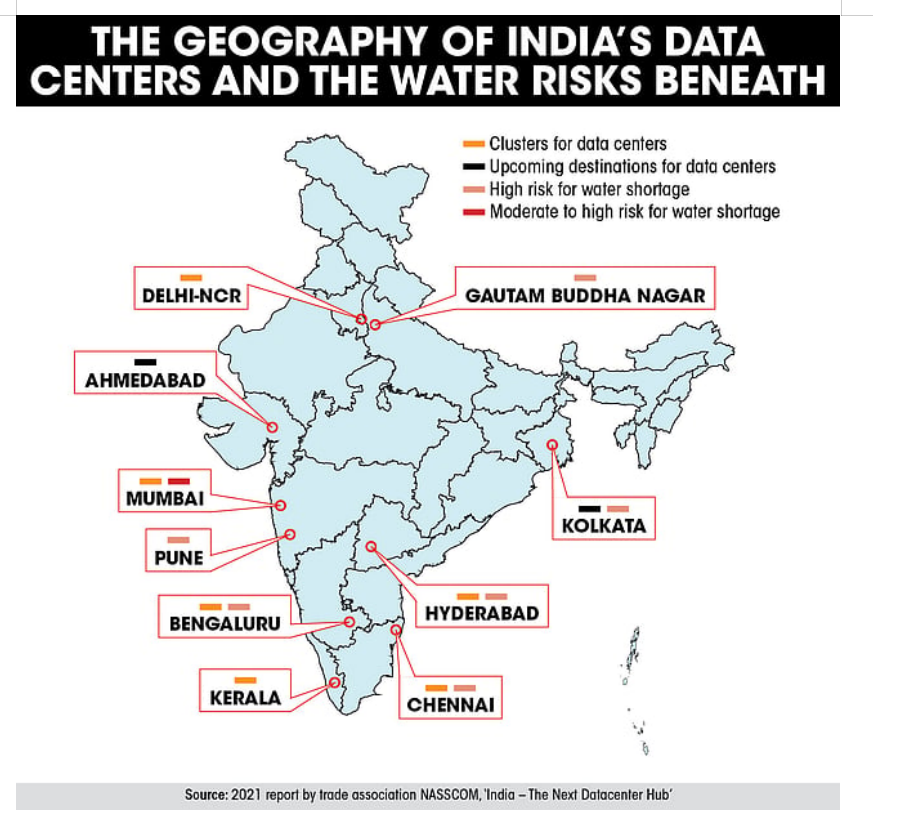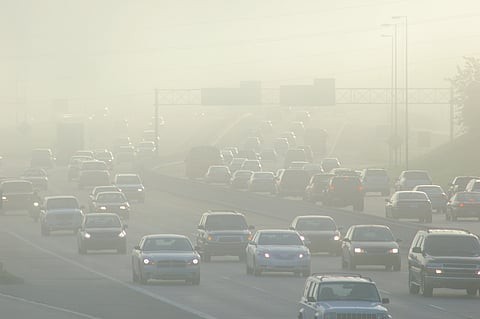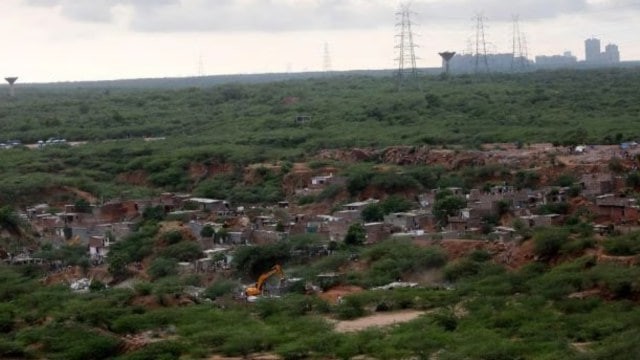Copyright infringement not intended
Picture Courtesy: Down to Earth
Context:
Bengaluru, India’s tech hub, is witnessing a boom in data centres, but this growth is worsening the city’s water scarcity.
What are data centres?
A data centre is a specialized facility designed to house IT infrastructure, including servers, storage systems, networking equipment, and software, to store, manage, process, and transmit large volumes of digital data. They serve as the backbone of the digital economy, supporting cloud computing, internet services, banking, e-commerce, AI applications, and enterprise IT operations.
Key Features:
- Servers and Storage:Centralized computing and storage systems for handling massive data workloads.
- Networking Equipment:Switches, routers, and firewalls that connect systems and ensure data flows securely.
- Power Supply & Cooling:Uninterrupted power systems (UPS) and advanced cooling mechanisms to maintain reliability and prevent overheating.
- Security:Physical and cyber security to protect sensitive data from breaches or disasters.
Current Status of data centres and water crisis:
- India’s data centre capacity is growing rapidly, key cities such as Bengaluru, Mumbai, Chennai and the DelhiNCR region are major hubs.
- One 30 MW facility in Bengaluru was estimated to need about 780 million litres of water annually(219,700 litres daily) for cooling.
- Many of these data centres are located in waterstressed regions. For instance, Bengaluru’s water supplies are under severe pressure (e.g., reservoir levels at 16% in March 2024) while new data facilities are being added.
- According to the Economic Survey of India (202425), the market may grow from USD 4.5 billion in 2023 to USD 11.6 billion by 2032 (CAGR 10.98%).

Picture Courtesy: Down to Earth
What is the implication of growth of data centres on India’s water crisis?
Environmental Implications
- Water Stress & Depletion:Data centres require large volumes of water for cooling, particularly in water-scarce regions like Bengaluru, Pune, and Chennai. This intensifies groundwater depletion and affects reservoir levels.
- Ecosystem Disruption:Over-extraction of groundwater may lower water tables, affect local flora and fauna, and reduce availability for agriculture and domestic use.
Social Implications
- Impact on Local Communities:Residents in villages near data centres often rely on tankers as borewells dry up, increasing daily hardship and potential conflicts over water allocation.
- Inequality in Water Access:Large industrial consumers may take precedence over households, exacerbating urban-rural water inequality.
Economic Implications
- Business Growth vs. Resource Scarcity:Data centres attract investment, create jobs, and boost digital infrastructure. But resource scarcity can limit sustainable expansion.
- Operational Costs:Increasing water scarcity may push companies to invest in expensive alternative cooling systems (like air cooling or recycled water systems).
Technological Implications
- Innovation Pressure:Rising water demand creates impetus for AI-driven water management, liquid cooling alternatives, and energy-efficient design.
- Global Benchmarking:International data centre standards (like LEED, Energy Star, and EU Code of Conduct for Data Centres) highlight best practices that India can adopt.
What are the government measures helps in addressing water crisis?
- Integrated Water Resource Management: The government has adopted a multi-pronged strategy emphasizing sustainable management of water at both surface and groundwater levels. This includes monitoring water bodies, regulating extraction, and restoring natural recharge systems. The approach moves away from ad-hoc interventions toward holistic water governancethat balances domestic, industrial, agricultural, and ecological needs.
- Groundwater Management and Regulation: Recognizing that groundwater is over-exploited in many regions, policies like the Atal Bhujal Yojanapromote community-based recharge, sustainable withdrawal, and participatory governance. Regulations mandate permits for borewell drilling, variable pricing, and strict monitoring to ensure long-term aquifer sustainability.
- Safe and Adequate Drinking Water Supply: Initiatives like the Jal Jeevan Missionaim to provide reliable piped water to rural households. This addresses both accessibility and quality, reducing dependence on tankers or over-extraction of local water sources.
- Urban Water Infrastructure and Resilience: Urban water stress is tackled through restoration of lakes, improved drainage, and stormwater management. Cities like Bengaluru are investing in surface-water rejuvenationand flood mitigation to maintain supply and reduce vulnerability to climate-induced extremes.
- Data-Driven Monitoring and Digital Governance: Technological tools—such as geotagging of water bodies, digital aquifer mapping, and water-use monitoring—enable informed policymaking. These efforts improve transparency, accountability, and precision in interventions.
Karnataka’s measure:
Geotagging and Monitoring of Water Bodies
- Objective:Improve monitoring, recharge, and protection of water bodies in water-stress regions.
- Implementation:Geotagged 31,033 out of 41,875 water bodies in Karnataka.
Regulatory Measures for Borewell Drilling
- Objective:Manage groundwater sustainably in severely stressed zones.
- Policy:All borewell drilling requires permits under Karnataka’s groundwater law, including for industrial users like data centres.
|
Case Study
Microsoft Data Centres, Quincy, Washington: Microsoft implemented a closed-loop water reuse system for its data centres in Quincy to reduce reliance on groundwater. The Quincy Water Reuse Utility treats cooling water for reuse, preventing discharge of mineral-rich wastewater and saving ~522 million litres/year. Key features include partnership with the city, closed-loop reuse, and adaptation to local water quality. This model demonstrates how data centres can operate sustainably in water-stressed regions, offering lessons for India: recycling cooling water, minimizing freshwater use, and integrating infrastructure with local water governance.
|
What we can do next?
- Data Centre Siting:Prioritize locations in areas with lower water stress or where alternative water sources (like treated wastewater) are available.
- Adopt Water-Saving Technologies:Use air-cooled servers, closed-loop cooling systems, and rainwater harvesting for operational needs.
- Incentivize Renewable Water Use:Provide subsidies or incentives for using rainwater and recycled water in data centres.
- Real-Time Water Monitoring:Expand geotagging and Internet of Things based monitoring of water bodies to track usage by industrial users
- Local Communities:Involve local panchayats in water governance, including data-centre water management plans.
- Periodic Policy Review:Ensure policies adapt to changing water-stress conditions and technological advances.
Conclusion:
India’s push for data-centre growth presents both economic opportunities and water-resource challenges. Policies in Karnataka and other regions show a commitment to balancing digital infrastructure expansion with sustainable water management. Moving forward, integrating efficient water use, regulatory enforcement, stakeholder engagement, and innovation will be crucial to ensure that the country’s digital ambitions do not strain its vital water resources.
Source: Down to Earth
|
Practice Question
Q. India is witnessing rapid growth of data centres, particularly in water-stressed regions. Discuss the challenges this poses for water resource management and suggest measures to ensure sustainable development of digital infrastructure. (250 words)
|
Frequently Asked Questions (FAQs)
- Data centres consume water primarily for cooling servers, maintaining equipment, and in some cases, for fire suppression systems.
- A large hyperscale data centre can use millions of litres per day, depending on cooling technology and local climate.
- Karnataka, particularly Bengaluru, is a tech hubattracting hyperscale and cloud data centres.
The state has implemented policies like the Karnataka Data Centre Policy 2022–2027 offering incentives and promoting renewable energy usage.












